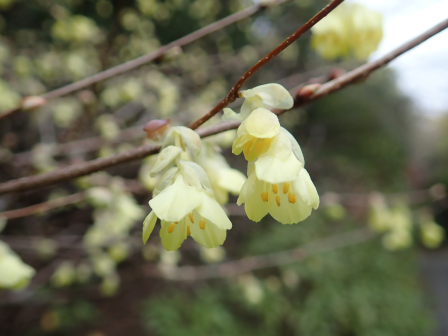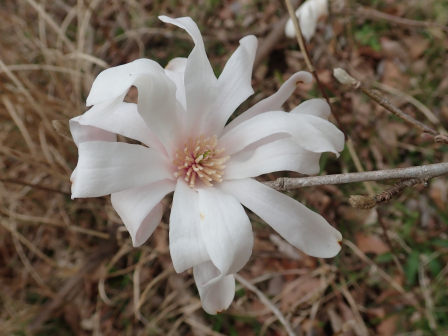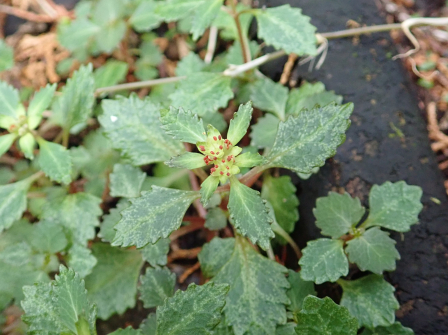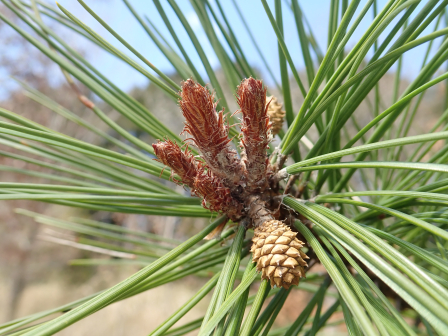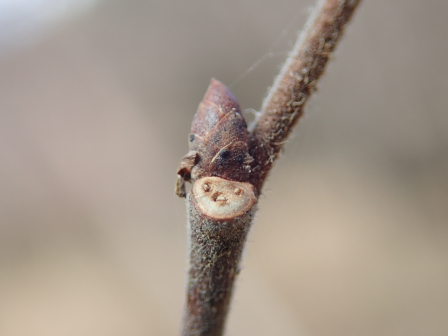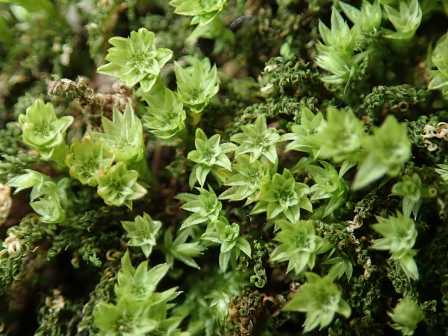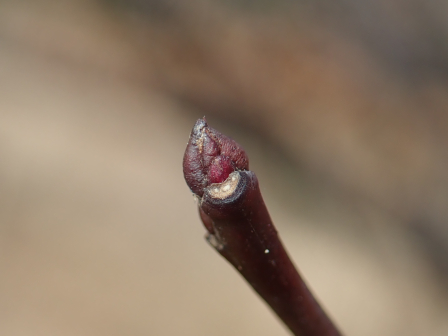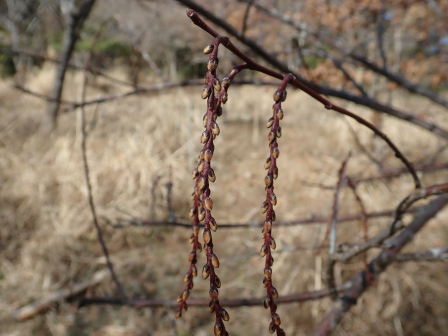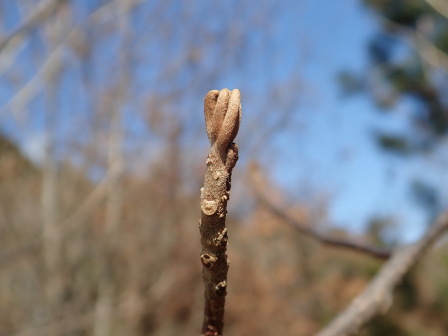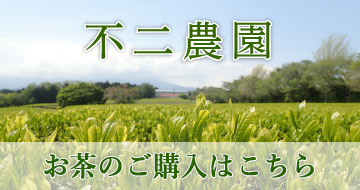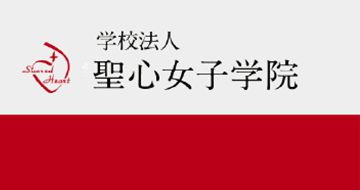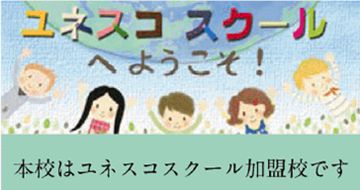フィールド日記
2022年03月
2022.03.29
ヒュウガミズキ
裏道でヒュウガミズキが咲いていました。近畿地方の日本海側など限られた地域にしか自生していませんが、各地で植栽されています。和名のヒュウガとは現在の宮崎県を指すと思われますが、最近まで宮崎県に自生するとは考えられていなかったため、由来はよくわかっていないようです。
A "Hyuuga-Mizuki (ヒュウガミズキ)" tree is in bloom on the back road. They, as wild plants, grow in limited areas such as the Japan Sea side of the Kinki region, but people in other places also plant the trees. "Hyuuga (ヒュウガ)" in its name could mean current Miyagi prefecture, but it's not clear where the name originally comes from, because it was found only recently that the trees grow in Miyagi prefecture.
2022.03.25
シデコブシ
共生の森に植栽されたシデコブシが咲いています。コブシに似ていますが、花びらがコブシよりもたくさんあるのが特徴です。野生として東海地方の一部のみに自生し、絶滅が危惧されていますが、庭木として各地に植栽されています。
The "Shide-Kobushi (シデコブシ)" tree planted in the Kyoseinomori-Forest(共生の森) is in bloom. They are similar to "Kobushi (コブシ)" trees, but they have more petals. "Shide-Kobushi" trees, as wild plants, grow in only a part of Tokai area and are considered an endangered species, but people in many places usually plant the trees in gardens.
2022.03.22
ニッコウネコノメ
裏道でニッコウネコノメが咲いていました。ネコノメソウの仲間は似ているものも多く、見分けるのが難しいものもあります。ニッコウネコノメはイワボタン(別名ミヤマネコノメ)の変種で、開花直後の葯が赤褐色であることと、がく片が斜開から平開することが特徴です。
"Nikkou-Nekonome (ニッコウネコノメ)" plants are in bloom on the back road. Plants belonging to "Nekonome-Sou (ネコノメソウ)" resemble each other, so sometimes it's difficult to tell one from the others. "Nikkou-Nekonome" plants are a variety of "Iwabotan (イワボタン)" plants. They are characterized by their dark red anthers immediately after flowering and their half-open or open sepals.
2022.03.18
アカマツ
写真は共生の森のアカマツの冬芽です。クロマツの冬芽は白っぽいのに対し、アカマツの冬芽は赤っぽいので簡単に見分けることができます。写真にある小さい松ぼっくりのようなものは前年の春に咲いた雌花で、今年の秋に熟します。つまり、アカマツは花が咲いてから種子ができるまで、1年半ほどかかります。
The photo shows the winter buds of an "Aka-Matsu (アカマツ)" tree planted in the Kyoseinomori-Forest (共生の森). "Aka-Matsu" trees have reddish winter buds while "Kuro-Matsu (クロマツ)" trees have whitish ones. The small pinecone-like thing in the photo is a female flower that bloomed last year and will ripen this fall. In other words, it takes "Aka-Matsu" trees a year and a half to bloom and produce seeds.
2022.03.15
ハルニレ
写真は共生の森に植栽されたハルニレの冬芽と葉痕です。春に花が咲くのでハルニレと呼ばれています。写真は昨年伸びた枝で、毛が生えています。ハルニレは街路樹として植えられることもあります。
The photo shows a winter bud and a leaf scar of a "Haru-Nire (ハルニレ)" tree planted in the Kyoseinomori-Forest (共生の森). "Haru (ハル)" in its name means "spring" and it comes from the fact that they bloom in spring. The twig in the photo grew last year, so it is hairy. "Haru-Nire" trees are often planted as roadside trees.
2022.03.11
コバノチョウチンゴケ
中学校舎の中庭にコバノチョウチンゴケが見られます。早春から鮮緑色の新芽を出すためよく目立ちます。写真は雄花盤と呼ばれるつくりで、芽の先端に造精器が集まってカップ状の形をつくっています。
I found a moss called "Kobano-Chouchin-Goke (コバノチョウチンゴケ)" in the courtyard of the junior high school building. They stand out because they sprout new bright green shoots in the spring. The photo shows the part called "splash-cup", which is a cup-shaped tip of its shoot filled with its antheridia.
2022.03.08
キブシ
写真は共生の森のキブシの冬芽と葉痕(葉が落ちた痕)です。葉痕には維管束痕(水や養分を運ぶ管の集まりの痕)が3つあり、顔のように見えます。
下の写真は花芽です。もうすぐ開花しそうです。
The first photo shows a winter bud and a leaf scar of a "Kibushi (キブシ)" tree planted in the Kyoseinomori-Forest (共生の森). Each leaf scar has three vascular bundle scars, so it looks like a face.
The second photo shows its flower buds. They will bloom soon.
2022.03.04
ホオノキ
写真はキャンプ場のホオノキの冬芽です。葉も花も大きいホオノキは、冬芽も大きく、3cm以上あります。冬芽は無毛の芽鱗に包まれています。(ホオノキの花のようすはこちら)
The photo shows a winter bud of a "Hoonoki (ホオノキ)" tree in the camp site. "Hoonoki" trees, whose leaves and flowers are large, have large winter buds, too. The winter buds are covered with hairless bud scales. (Click here to read an article about the flowers of "Hoonoki")
2022.03.01
アワブキ
写真は共生の森に植栽されているアワブキの冬芽です。冬芽は裸芽で、褐色の毛が密に生えており、手袋のような形をしています。アワブキはスミナガシやアオバセセリなどの蝶の幼虫の食樹です。
The photo shows the winter buds of an "Awabuki (アワブキ)" tree planted in the Kyoseinomori-Forest (共生の森). The buds categorized as "naked buds" are densely covered with brown hair and they look a glove. "Awabuki" trees are a host plant for the larvae of the butterflies such as "Suminagashi (スミナガシ)" and "Aoba-Seseri (アオバセセリ)".
- 1 / 1


